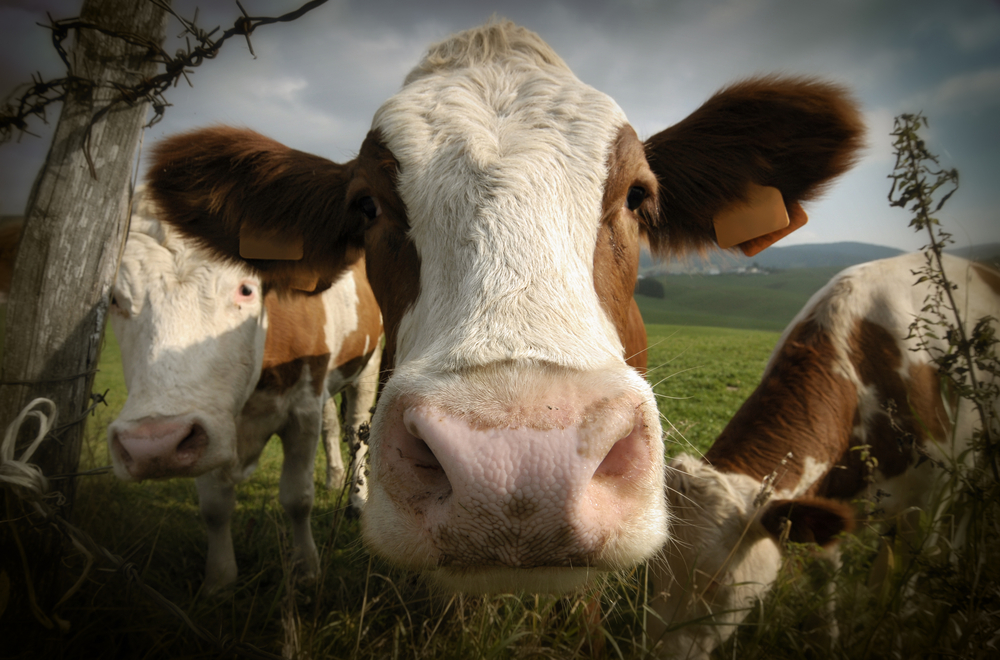Eh. Meat, shmeat. No, really. Shmeat. It’s the, um, hip term for lab-grown meat (as Kate Sheppard explained in Mother Jones, shmeat = a sheet of meat). Not exactly what you’d expect the marketing whizzes to come up with, but lack of a catchy name is hardly the biggest problem facing the developers of lab-grown meat. Making enough of it to feed to a human had been the biggest. But that milestone has finally fallen by the wayside.
Earlier this week, two curious gastronomes, Austrian food researcher Hanni Ruetzler and American technology and food writer Josh Schonwald, ate a hamburger made of meat grown in a test tube by Dutch vascular physiologist Mark Post. The world’s most expensive hamburger, it cost $332,000 and was underwritten by none other than Google co-founder Sergey Brin. Yes. I’ll go there. Lab-grown meat should be forever be known as Brinburger. You’re welcome, internet.
Grist has been covering the slow progression of lab-grown meat for nearly a decade, in particular Post’s long-running effort. This week’s hamburger-related festivities had been rescheduled from October 2012. Scientific American explains the process:
The hamburger was grown in Post’s lab using bovine skeletal muscle stem cells, collected from a piece of fresh beef. To do this, the cells were “fed” calf serum and commercially available growth medium to initiate multiplication and prompt them to develop into muscle cells over time. Once they differentiated into muscle cells, they were given simple nutrient sources, such as algae extracts. The scientists also exercised the resulting muscle strands in a bioreactor by affixing them to a soluble sugar scaffold and slowly built tension using doughnut-shaped anchor points—essentially helping the muscle to “bulk up.”
Of course, all of that produces no more than a thin, small strip of meat. SciAm reported that it took 20,000 such strips, grown over three months, to make one five-ounce burger. How did it taste? Not so bad! Sayeth BBC News:
Ms Ruetzler said: “I was expecting the texture to be more soft … there is quite some intense taste; it’s close to meat, but it’s not that juicy. The consistency is perfect, but I miss salt and pepper.”
She added: “This is meat to me. It’s not falling apart.”
Food writer Mr. Schonwald said: “The mouthfeel is like meat. I miss the fat, there’s a leanness to it, but the general bite feels like a hamburger.
“What was consistently different was flavour.”
Part of the issue was that the burger was all lean beef, lacking entirely in fat — far from ideal as any beefeater can tell you. For it to be recognizable as meat, it also had to be colored, as its out-of-the-tube state is yellowish-white. (Yum!) For that, Post used beet-root juice, saffron, and caramel (although some reports claimed the latter ingredients were used to enhance flavor). In the future, Post wants to use the naturally occurring blood pigment myoglobin as a coloring.
And to ensure a fair test, both tasters only ate the meat, refusing the offered tomato, lettuce, and bun. Anything for the sake of science.
While Brin opened his checkbook for the project out of animal welfare concerns (we needn’t worry about mistreated animals if there are no animals in the meat-making process), Post’s main motivation appears to be the land and environmental impacts of the livestock industry, which are significant. A majority of global agricultural lands are dedicated to grazing and, in the U.S., over a third of the grain harvest goes to livestock feed. Then there’s the greenhouse gas “contributions” of livestock, which are significant, with beef having one of the largest climate impacts of any food, according to the Environmental Working Group.
A 2011 study in the peer-reviewed journal Environmental Science and Technology found that lab-grown beef would use 45 percent less energy, produce 96 percent fewer greenhouse gas emissions, and use 99 percent less land than conventionally produced meat. So there’s that.
But to suggest, as Post does, that this is a key to a “feed the world” strategy is probably overstating the case. While Post expects to scale up his efforts and become cost-competitive in the next 10 to 20 years, this will be a first-world product for decades beyond that.
In fact, David Biello, also writing in Scientific American, which covered the lab meat issue extensively a couple years ago, points out something that makes meat grown in a lab ominously similar to its factory-farmed brethren: They’re both doused in antibiotics. (Not a good thing.) And it’s possible that shmeat has fewer nutrients than even the worst kind of industrially produced animal meat:
[T]he in vitro meat features heavy antibiotic use to keep the cells alive and growth on serum from the blood of unborn cows gathered from slaughterhouses (as well as the less gruesome sugars, proteins and fatty acids).
Then the meat requires “exercise” on a scaffold. There are questions about its nutritional value as well, such as how much iron it might contain compared with traditional meat.
I’d add to that that the inherent deficiencies in shmeat, which lacks fat and most of the components that add flavor, is an open invitation to a seat at the food chemists’ lab bench. Is it hard to imagine that a Brinburger wouldn’t ultimately get the Subway Sweet Onion Chicken Teriyaki Sandwich treatment, in which “potassium chloride (salt), maltodextrin (a starchy thickener), autolyzed yeast extract (a cheap substitute for MSG), gum arabic (tree sap used as a stabilizer), soy protein concentrate (cheap protein additive), and sodium phosphates (more salt!)” are added to tart up the meat.
Biello also quotes a synthetic biologist, Christina Agapakis, who obeserved that: “Cell culture is one of the most expensive and resource-intensive techniques in modern biology.” That has to radically change for this to be anything more than a media stunt.
Now I’ve stated in the past that I’m skeptical of sci-tech solutions to large-scale food-system problems (though I think many people misinterpreted my arguments as being against science and technology generally — agroecological farming practices, for example, are sophisticated and inherently science-based and I’m a big fan of those). I am, however, skeptical of a free lunch. And the argument that shmeat will magically do away with all the downsides of livestock products strikes me as just that.
Still, I wouldn’t totally discount the possibility that lab-grown meat will eventually be able to compete in the processed food and fast food sector, where quality isn’t as much of a factor and scientists can add in whatever they need in terms of flavor and texture and so on. Lab-grown meat will likely be given an added boost by the continued rise of the price of farmed meat, driven by climate impacts like drought and heat already affecting prime U.S. farmland.
In some ways, lab-grown meat represents what is an increasingly divergent food system: Those with the means can maintain an “authentic,” “healthy” diet of “real food.” Those who can’t, get the best the food factories can offer, whether that’s the current crop of high-fat, low-nutrient processed food or Post’s vision of lab-grown meat.




